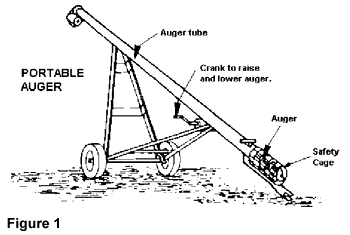 Portable
augers are among the most dangerous pieces of equipment on
the farmstead (see Figure 1). Due to their size, most are
difficult to maneuver. Whenever a large auger is moved, it
should be lowered to its transport position. When at the use
site, it can be raised to its proper operating height.
Portable
augers are among the most dangerous pieces of equipment on
the farmstead (see Figure 1). Due to their size, most are
difficult to maneuver. Whenever a large auger is moved, it
should be lowered to its transport position. When at the use
site, it can be raised to its proper operating height.
Most auger accidents are operator-caused. Only persons authorized to operate the auger or elevator should be in the work area. To help reduce accidents, the operator should be in the work area. To help reduce accidents, the operator should wear clothing that is snug fitting without any loose thread or string that could become entangled in belts or drives. Footwear should be well fitting with a non-skid sole. Always make sure guards and shields are in place when the equipment is running.
During a recent year, power take-off accidents in Montana resulted in the loss of a leg at the knee, an arm at the shoulder and extensive head, neck and spine damage. These injuries will reduce the efficiency of these people for the rest of their lives.
There are a number of types of accidents that can occur with the operation of an elevator or auger. Both produce similar types of injuries. Auger accidents usually include:
The portable auger is the major cause of farm-related amputations. Severe lacerations or amputations that result from contact with the auger screw are caused by it's high-speed cutting actions. Such accidents usually result in considerable loss of blood. Stoppage of bleeding, important in all accidents, is extremely important in auger accidents. The primary concerns for accidents that involve amputation or severe lacerations are the time the person has been in the machine and extrication o the victim. The body part may have been pulled far enough into the auger so that it is hard to reach the wound for direct pressure. It may be necessary to use pressure-point techniques to stop the blood flow.
When at the accident, secure all equipment involved in the accident to ensure that it cannot be started automatically. This may require shutting off the tractor, locking out all electrical circuits that operate electric motors or removing the spark plug wire from small gasoline engines.
To remove the victim from an auger, if in it's raised position, lower it slowly, using extreme care. Letting the crank handle get out of control may allow the auger to fall to a collapsed position, which may increase the injury or injure someone else.
Determine the approximate location of the part of the body that is in the auger. If penetration of the victim's limb is minimal, the auger sometimes can be turned backward to relieve the pressure. Sometimes this can be done by hand. If not, a bar placed in the power drive unit yoke, or a pipe wrench may be required to rotate the auger counterclockwise. If it is not possible to reverse the auger, use a portable air chisel to cut away the metal housing or shielding to expose the limb. Use o an acetylene torch requires extreme caution, fire extinguishers and protection for the victim. After the auger screw and limb are exposed, there is less danger of added injury during extraction of the person caught in the auger.
If the accident is caused by contact of the auger or elevator with an overhead power line, the rescue requires extreme concentration and caution. The auger or elevator may still be in contact with the power line, and remain energized. Victims still in contact with the energized auger or elevator must be removed by shoving them away with a dry stick or a board or pulling them away with a non-conducting piece of cloth or rope. It would be a good idea for the rescuer to have rubber-soled footwear and rubber or plastic gloves. As soon as the victim is free from the electrically charged equipment, treatment must commence.
If the victim is not breathing, cardiopulmonary resuscitation (CPR) procedures should be initiated immediately. Ventricular fibrillation or cardiac standstill also may require CPR. The victim probably will have burns at points where the electrical current entered and exited. The injury damage at these points, however, usually is considered to be a secondary wound because there usually is little or no bleeding due to cauterization of the wounds by the electrical current. Rubbersoled shoes o plastic or rubber gloves worn by the person trying to rescue the victim may not be adequate to protect against electrocution. Therefore, a person attempting to rescue the victim of an accident involving electricity must use extreme care not to touch victims until they are completely away from the auger or elevator. It is far better for the rescuer to obtain help from a person trained in handling high-voltage power.
PTO drive lines on augers and elevators can cause the same types of injuries that occur with such other power take-off drive units as those on a baler, manure spreader or rock picker. Such injuries may consist of broken arms or legs, amputations, lacerations and even tearing large areas of skin and flesh from the body. The main type of injury in accidents that involve elevators is a victim caught by the power line drive unit. For rescue details see MontGuide 8701A, Power Take-off Accident Victim Rescue.
Publication #: MT 8702
This document is apart of a series from the Montana State University Extension. Publication date: February 1987.
Roy Linn, Energy Specialist. Montana State University Extension, Bozeman, Montana 59717.
Disclaimer and Reproduction Information: Information in NASD does not represent NIOSH policy. Information included in NASD appears by permission of the author and/or copyright holder. More